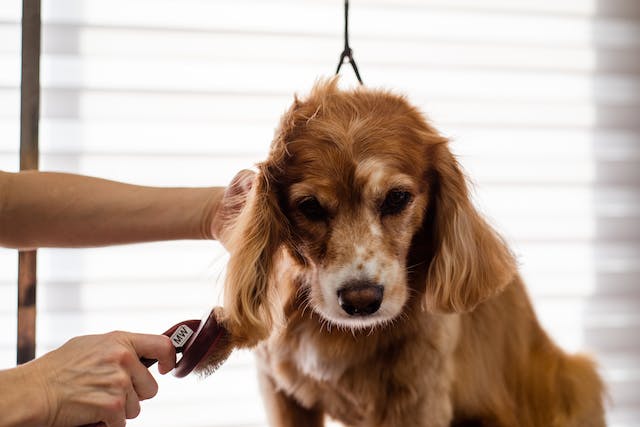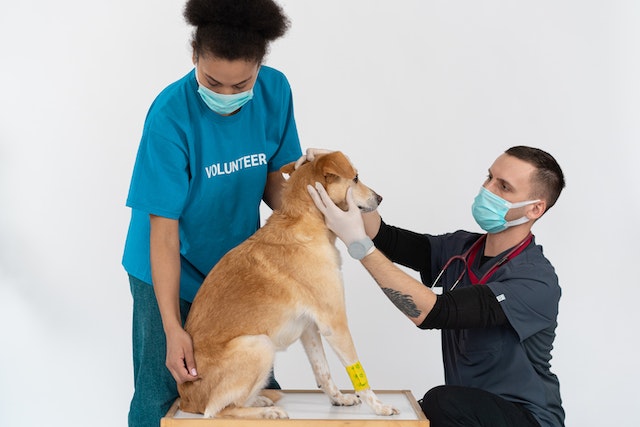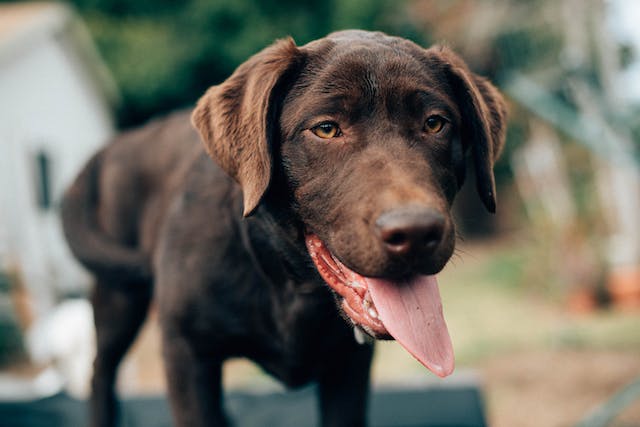11 Most Common Dog Hairball Symptoms

Let’s discuss dog hairball symptoms…
If you think hairballs are just a cat thing, think again! Our furry canine companions can also experience the not-so-fun phenomenon of hairballs.
In this article, we’ll explore the telltale signs of dog hairballs and share some tips on how to deal with them.
So, let’s dive in and keep those wagging tails hairball-free!
Dog Hairball Symptoms
Dog hairballs are relatively rare compared to cats, but when they occur, symptoms may include coughing, gagging, retching, and occasional vomiting.
It’s important to monitor your dog closely and consult a veterinarian if hairball symptoms persist or worsen.
Let’s break it down further…
Here are some of the most common dog hairball symptoms:
1. Occasional Vomiting
Sometimes, you might notice your furry friend occasionally vomiting. While vomiting can be caused by various factors, one possible reason could be the presence of hairballs.
When dogs groom themselves, they tend to swallow loose hair. Over time, this hair can accumulate in their stomach, forming a hairball.
When the hairball becomes too large or irritating, it can trigger occasional vomiting. So, if you find your dog occasionally throwing up, it could be a sign that they have a hairball.
2. Coughing
Have you ever heard your pup coughing or making hacking sounds? Well, coughing can also be a symptom of hairballs.
When a hairball gets stuck in your dog’s throat, it can cause irritation and lead to coughing. The coughing may be dry and persistent, as if your dog is trying to clear their throat.
If you hear your dog coughing frequently, especially after grooming or eating, it’s possible that a hairball is causing the discomfort.
3. Retching
Now, let’s talk about retching. Retching is a common symptom associated with hairballs in dogs.
It’s the act of trying to vomit or expel something from the stomach. When a hairball becomes large or obstructs the digestive tract, it can trigger retching.
Your dog may make gagging sounds, appear distressed, and try to vomit but without producing anything. Retching is a clear indication that your dog is experiencing discomfort due to a hairball.
4. Gagging
Gagging is often closely related to retching and can be another sign of a hairball problem in dogs.
When a hairball is stuck in the throat or esophagus, it can cause your dog to gag. Gagging is a reflex action in which the muscles in the throat contract as if attempting to expel something.
It may sound like a choking or hacking noise. If you notice your dog gagging frequently, especially after grooming or eating, it could be due to a hairball irritating their throat.
5. Visible Hair in Vomit
If your dog has hairballs, one of the most noticeable symptoms is the presence of visible hair in their vomit.
When dogs groom themselves, they often swallow loose hair, and sometimes it can accumulate in their stomach and form a hairball.
When the hairball becomes too large or irritating, it can trigger vomiting, and you may see strands of hair in the vomit.
It’s important to note that occasional vomiting can be normal for dogs, but if you notice a frequent occurrence of hair in their vomit, it could be a sign of hairball issues.
6. Loss of Appetite
Hairballs can cause discomfort and irritation in a dog’s digestive system, leading to a loss of appetite.
If your dog is experiencing hairball-related issues, they may show a decreased interest in food or refuse to eat altogether.
It’s important to monitor their eating habits and consult with a veterinarian if the loss of appetite persists or is accompanied by other concerning symptoms.
7. Constipation
Hairballs can sometimes obstruct the digestive tract, leading to constipation in dogs.
When hair accumulates in the stomach and intestines, it can create a blockage that hinders normal bowel movements.
If your dog is straining to defecate, producing small or hard stools, or showing signs of discomfort during elimination, it could be a sign of hairball-related constipation.
It’s essential to address this issue promptly to prevent further complications.
8. Abdominal Discomfort
Another common symptom of hairballs in dogs is abdominal discomfort. Dogs may exhibit signs of discomfort such as restlessness, pacing, whining, or a hunched posture.
They might also display increased sensitivity when their abdomen is touched. This discomfort is typically caused by the hairball’s presence and the associated irritation it creates in the digestive system.
If you notice these signs, it’s advisable to consult with a veterinarian for a proper diagnosis and treatment.
9. Difficulty Swallowing
If your dog is experiencing difficulty swallowing, it could be a sign of a hairball issue.
When hairballs form in your dog’s digestive tract, they can cause a blockage or irritation, making it harder for them to swallow their food.
You may notice your dog drooling excessively, coughing or gagging while eating, or even refusing to eat altogether.
It’s important to monitor your dog closely and seek veterinary attention if the difficulty swallowing persists or worsens.
10. Frequent Attempts to Eat Grass
Dogs are known to eat grass occasionally, but if you notice that your dog is constantly seeking out and eating grass, it could be a sign of hairball problems.
Grass acts as a natural emetic, meaning it can induce vomiting. Dogs instinctively eat grass to try and alleviate any discomfort caused by hairballs in their stomach or throat.
If your dog is excessively eating grass or showing signs of repeated vomiting, it’s essential to consult your veterinarian for a proper diagnosis and treatment plan.
11. Lack of Bowel Movements
A lack of bowel movements or constipation can be another symptom of hairball issues in dogs. Hairballs can cause a blockage in the gastrointestinal tract, making it difficult for your dog to pass stool.
If you notice that your dog is straining or having difficulty during bowel movements, or if they haven’t had a bowel movement for an extended period, it’s important to consult your veterinarian.
They can evaluate your dog’s condition, determine the underlying cause, and provide appropriate treatment, which may include hairball remedies or other interventions.
Learn more about hairballs in dogs.
Home Remedies for Dog Hairballs
Dealing with dog hairballs can be a real challenge, but there are some effective home remedies that can help. Here are a few ideas to consider:
Pumpkin
Adding plain, canned pumpkin to your dog’s meals can be beneficial in a few ways.
Pumpkin is high in fiber, which can aid in digestion and help to move hair through the digestive tract.
The fiber content can also promote regular bowel movements, reducing the likelihood of hairballs forming.
It’s important to note that you should use plain, canned pumpkin without any added sugar or spices.
Coconut Oil
Coconut oil is known for its potential digestive benefits for dogs. It can help lubricate the digestive system, making it easier for hairballs to pass through.
Additionally, coconut oil has antimicrobial properties that can support gut health.
When using coconut oil for dogs, it’s important to start with small amounts and gradually increase as needed.
Regular Brushing
Regular grooming and brushing are essential for preventing hairballs in dogs.
By brushing your dog’s coat frequently, especially during shedding seasons, you can remove loose hair before it’s ingested.
This reduces the amount of hair that your dog swallows, lowering the risk of hairball formation.
Hydration
Keeping your dog well-hydrated is crucial for overall health, including the prevention of hairballs.
Adequate water intake helps to maintain healthy digestion and can assist in moving hair through the digestive system.
Be sure to provide fresh water for your dog at all times, and consider moistening dry food with water to increase your dog’s fluid intake.
Commercial Hairball Remedies
There are various commercial products designed to help prevent and manage hairballs in dogs.
These products often contain ingredients that support digestive health, such as fiber, enzymes, and oils.
They can come in the form of treats, chews, or supplements that are convenient to administer to your dog.
When considering a commercial hairball remedy, it’s best to consult with your vet to ensure it’s suitable for your dog’s specific needs and health status.
By incorporating these remedies into your dog’s care routine, you can help minimize the discomfort and health risks associated with hairballs.
As always, consulting with a veterinarian is important to ensure that the chosen remedies are safe and appropriate for your dog’s individual needs.
Read more about home remedies for hairballs in dogs.
Related Questions
What are the common symptoms of a dog having a hairball?
If your dog is experiencing a hairball, you might notice symptoms like frequent coughing, hacking, or attempts to vomit without producing anything. They might also show a decrease in appetite or energy.
How can I tell if my dog’s coughing is due to a hairball or something else?
It can be tricky, but if your dog’s coughing is accompanied by the retching or gagging sound, it’s likely due to a hairball. However, if you’re unsure, it’s best to consult with your vet to rule out any other potential health issues.
Can I help prevent hairballs in my dog?
Absolutely! Regular grooming and brushing can significantly reduce the amount of loose hair your dog ingests. Additionally, feeding a high-fiber diet or using specially formulated hairball control foods can help prevent hairballs from forming.
Learn more about caring for dogs.
Should I be concerned if my dog occasionally coughs up a hairball?
It’s fairly common for dogs to pass a hairball from time to time, especially during shedding seasons. However, if your dog is experiencing frequent or severe hairball-related symptoms, it’s best to seek advice from your vet.
What should I do if I suspect my dog has a hairball?
If you suspect your dog has a hairball, monitor their symptoms and behavior closely. Offer plenty of water to help the hairball move through the digestive tract, and if the symptoms persist or worsen, consult your vet for guidance.
Learn more about the benefits of regular grooming in dogs.
Conclusion
In conclusion, if you notice your furry friend exhibiting unusual symptoms like coughing, gagging, or hacking, don’t overlook the possibility of dog hairballs. Remember, regular grooming and brushing can help prevent excessive shedding and reduce the risk of hairball formation. So, keep an eye on your pup’s grooming routine and ensure their coat stays healthy and tangle-free. Your dog will thank you for it!




![Dog Not Eating But Throwing Up [9 Reasons & Tips] Dog Not Eating But Throwing Up](https://petcreeks.com/wp-content/uploads/2023/04/Dog-Not-Eating-But-Throwing-Up-768x555.jpg)

